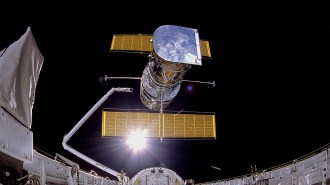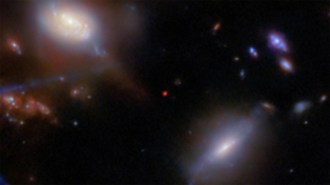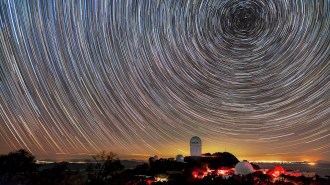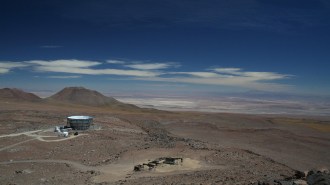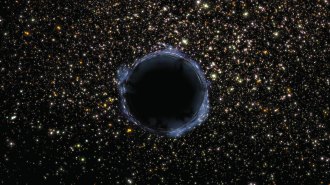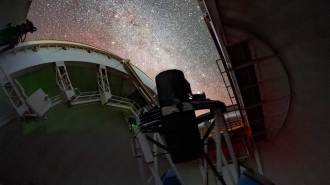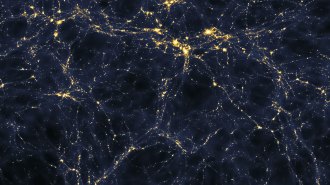The dark matter mystery deepens with the demise of a reported detection
A new experiment fails to support previous report of WIMPs in space
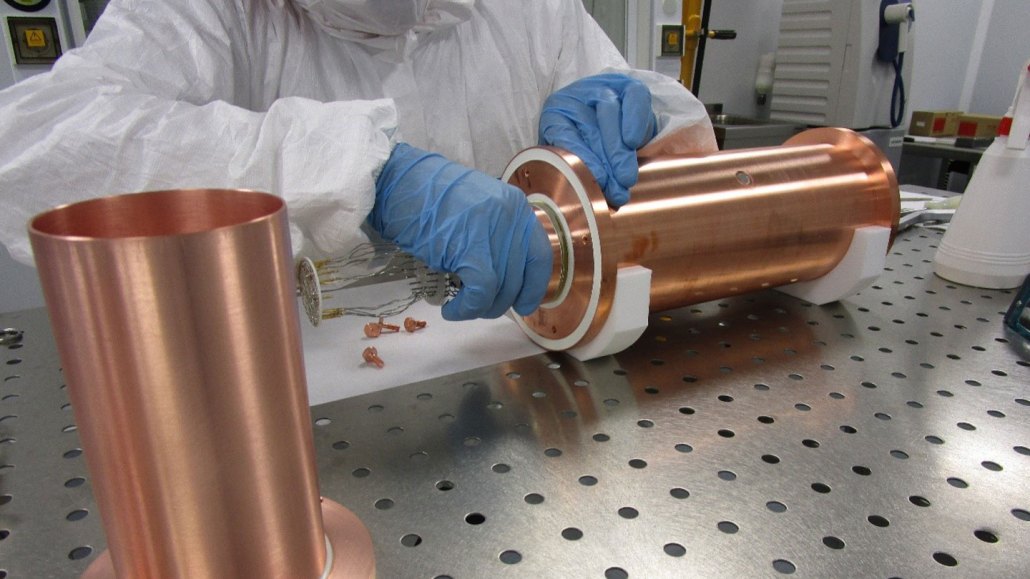
A lab worker prepares a module containing sodium iodide for use in the ANAIS experiment, designed to detect dark matter, at an underground laboratory in Spain.
ANAIS/CAPA, Universidad Zaragoza
First of two parts. Read part two.
In mystery stories, the chief suspect almost always gets exonerated before the end of the book. Typically because a key piece of evidence turned out to be wrong.
In science, key evidence is supposed to be right. But sometimes it’s not. In the mystery of the invisible “dark matter” in space, evidence implicating one chief suspect has now been directly debunked. WIMPs, tiny particles widely regarded as prime dark matter candidates, have failed to appear in an experiment designed specifically to test the lone previous study claiming to detect them.
For decades, physicists have realized that most of the universe’s matter is nothing like earthly matter, which is made mostly from protons and neutrons. Gravitational influences on visible matter (stars and galaxies) indicate that some dark stuff of unknown identity pervades the cosmos. Ordinary matter accounts for less than 20 percent of the cosmic matter abundance.
For unrelated reasons, theorists have also long suggested that nature possesses mysterious types of tiny particles predicted by a theoretical mathematical framework known as supersymmetry, or SUSY for short. Those particles would be massive by subatomic standards but would interact only weakly with other matter, and so are known as Weakly Interacting Massive particles, hence WIMPs.
Of the many possible species of WIMPs, one (presumably the lightest one) should have the properties necessary to explain the dark matter messing with the motion of stars and galaxies (SN: 12/27/12). Way back in the last century, searches began for WIMPs in an effort to demonstrate their existence and identify which species made up the dark matter.
In 1998, one research team announced apparent success. An experiment called DAMA (for DArk MAtter, get it?), consisting of a particle detector buried under the Italian Alps, seemingly did detect particles with properties matching some physicists’ expectations for a dark matter signal.
It was a tricky experiment to perform, relying on the premise that space is full of swarms of WIMPs. A detector containing chunks of sodium iodide should give off a flash of light when hit by a WIMP. But other particles from natural radioactive substances would also produce flashes of light even if WIMPs are a myth.
So the experimenters adopted a clever suggestion proposed earlier by physicists Katherine Freese, David Spergel and Andrzej Drukier, known formally as an annual modulation test. But let’s just call it the June-December approach.
As the Earth orbits the sun, the sun also moves, traveling around the Milky Way galaxy, carried by a spiral arm in the direction of the constellation Cygnus. If the galaxy really is full of WIMPs, the sun should be constantly plowing through them, generating a “WIMP wind.” (It’s like the wind you feel if you stick your head out of the window of a moving car.) In June, the Earth’s orbit moves it in the same direction as the sun’s motion around the galaxy — into the wind. But in December, the Earth moves the opposite direction, away from the wind. So more WIMPs should be striking the Earth in June than in December. It’s just like the way your car windshield smashes into more raindrops when driving forward than when going in reverse.
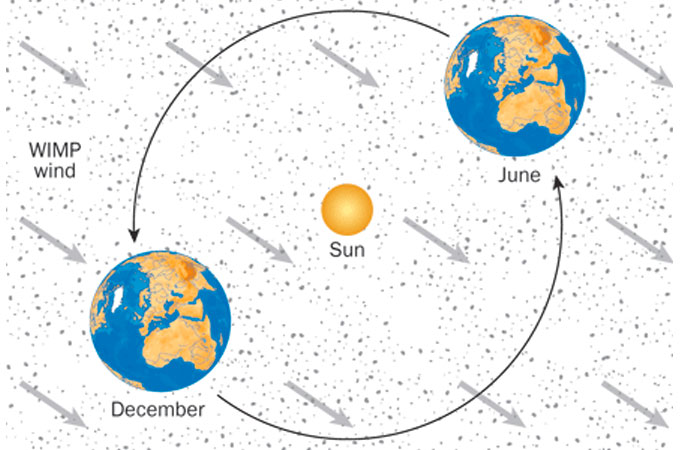
GEOATLAS/GRAPHI-OGRE, ADAPTED BY T. DUBÉ
At an astrophysics conference in Paris in December 1998, Pierluigi Belli of the DAMA team reported a clear signal (or at least a strong hint) that more particles arrived in June than December. (More precisely, the results showed an annual modulation in frequency of light flashes, peaking around June with a minimum in December.) The DAMA data indicated a WIMP weighing in at 59 billion electron volts, roughly 60 times the mass of a proton.
But some experts had concerns about the DAMA team’s data analysis. And other searches for WIMPs, with different detectors and strategies, should have found WIMPs if DAMA was right — but didn’t. Still, DAMA persisted. An advanced version of the experiment, DAMA/LIBRA, continued to find the June-December disparity.
Perhaps DAMA was more sensitive to WIMPs than other experiments. After all, the other searches did not duplicate DAMA’s methods. Some used substances other than sodium iodide as a detecting material, or watched for slight temperature increases as a sign of a WIMP collision rather than flashes of light.
For that matter, WIMPs might not be what theorists originally thought. DAMA initially reported 60 proton-mass WIMPs based on the belief that the WIMPs collided with iodine atoms. But later data suggested that perhaps the WIMPs were hitting sodium atoms, implying a much lighter WIMP mass — lighter than other experiments had been optimally designed to detect. Yet another possibility: Maybe trace amounts of the metallic element thallium (much heavier atoms than either iodine or sodium) had been the WIMP targets. But a recent review of that proposal found once again that the DAMA results could not be reconciled with the absence of a signal in other experiments.
And now DAMA’s hope for vindication has been further dashed by a new underground experiment, this one in Spain. Scientists with the ANAIS collaboration have repeated the June-December method with sodium iodide, in an effort to reproduce DAMA’s results with the same method and materials. After three years of operation, the ANAIS team reports no sign of WIMPs.
To be fair, the no-WIMP conclusion relies on a lot of seriously sophisticated technical analysis. It’s not just a matter of counting light flashes. You have to collect rigorous data on the behavior of nine different sodium iodide modules. You have to correct for the presence of rare radioactive isotopes generated by cosmic ray collisions while the modules were still under construction. And then the statistical analysis needed to discern a winter-summer signal difference is not something you should try at home (unless you’re fully versed in things like the least-square periodogram or the Lomb-Scargle technique). Plus, ANAIS it still going, with plans to collect two more years of data before issuing a final analysis. So the judgment on DAMA’s WIMPs is not necessarily final.
Nevertheless, it doesn’t look good for WIMPs, at least for the WIMPs motivated by belief in supersymmetry.
Sadly for SUSY fans, searches for WIMPs from space are not the only bad news. Attempts to produce WIMPs in particle accelerators have also so far failed. Dark matter might just turn out to consist of some other kind of subatomic particle.
If so, it would be a plot twist worthy of Agatha Christie, kind of like Poirot turning out to be the killer. For symmetry has long been physicists’ most reliable friend, guiding many great successes, from Einstein’s relativity theory to the standard model of particles and forces.
Still, failure to find SUSY particles so far does not necessarily mean they don’t exist. Supersymmetry just might be not as simple as it first seemed. And SUSY particles might just be harder to detect than scientists originally surmised. But if supersymmetry does turn out not to be so super, scientists might need to reflect on the ways that faith in symmetry can lead them astray.

